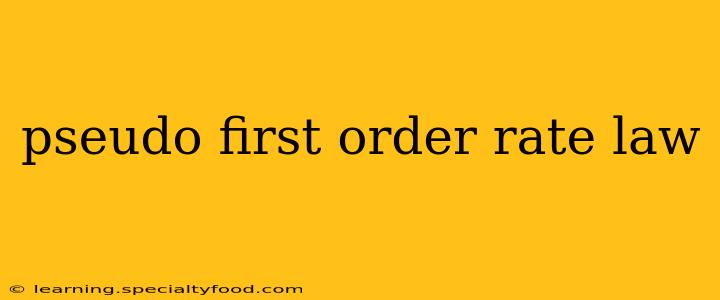Chemical kinetics is all about understanding reaction rates. Sometimes, reactions appear to follow simpler kinetics than they actually do, leading to the concept of the pseudo first-order rate law. This isn't a separate law, but rather a simplification of a more complex rate law under specific conditions. Let's delve into what makes it work and why it's so useful in chemistry.
What is a Pseudo First-Order Reaction?
A pseudo first-order reaction is a second-order (or higher) reaction that's made to behave like a first-order reaction by having one reactant present in a large excess. This large excess effectively keeps the concentration of that reactant essentially constant throughout the reaction.
Consider a general second-order reaction:
A + B → Products
The rate law is typically expressed as:
Rate = k[A][B]
where:
- k is the rate constant
- [A] and [B] are the concentrations of reactants A and B
If we have a large excess of reactant B, its concentration ([B]) remains virtually unchanged during the course of the reaction. We can then treat [B] as a constant. The rate law simplifies to:
Rate = k'[A]
where k' = k[B] is a new, pseudo first-order rate constant. This new equation now looks like a first-order rate law, even though the underlying reaction is second order. That's why we call it a pseudo first-order reaction.
Why Use the Pseudo First-Order Approximation?
The key advantage is simplification. First-order reactions are much easier to analyze and understand than higher-order reactions. Their integrated rate laws are simpler, and determining the rate constant is straightforward. By using a large excess of one reactant, we can simplify the kinetics, making the analysis more manageable.
This technique is frequently used in experimental situations where:
- One reactant is very expensive or difficult to obtain: Using a large excess of the cheaper reactant simplifies experimentation.
- One reactant is very reactive: A large excess ensures that the reaction proceeds at a measurable rate.
- The reaction mechanism is complex and needs simplification: A pseudo first-order approach can help isolate the rate-determining step.
How to Determine if a Reaction is Pseudo First-Order
You can determine if a reaction follows pseudo first-order kinetics by experimentally varying the concentrations of the reactants. If the reaction rate changes proportionally only to the concentration of one reactant while keeping the other(s) significantly in excess, it suggests a pseudo first-order behavior. The rate will appear independent of the reactant(s) in excess.
Examples of Pseudo First-Order Reactions
Many reactions in organic chemistry, particularly those involving hydrolysis or esterification, are studied under pseudo first-order conditions. For example, the acid-catalyzed hydrolysis of an ester:
Ester + H₂O → Acid + Alcohol
If water is present in large excess, the reaction will exhibit pseudo first-order kinetics with respect to the ester.
What is the integrated rate law for a pseudo first-order reaction?
The integrated rate law for a pseudo first-order reaction mirrors that of a true first-order reaction:
ln([A]t) = -k't + ln([A]₀)
Where:
- [A]t is the concentration of reactant A at time t
- k' is the pseudo first-order rate constant
- [A]₀ is the initial concentration of reactant A
This equation allows for easy determination of the pseudo first-order rate constant (k') from experimental data. Plotting ln([A]t) versus time will give a straight line with a slope of -k'.
How does the half-life relate to a pseudo first-order reaction?
The half-life (t₁/₂) of a pseudo first-order reaction, like a true first-order reaction, is independent of the initial concentration:
t₁/₂ = ln(2) / k'
This simplifies analysis considerably.
In conclusion, the pseudo first-order rate law is a valuable tool for simplifying the kinetic analysis of complex reactions. By carefully controlling reactant concentrations, we can make seemingly intricate reactions behave like simpler first-order reactions, leading to easier data analysis and a clearer understanding of the reaction's mechanism.
